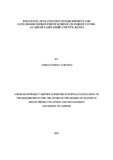| dc.description.abstract | There has been increasing rate of forest destruction and consequently decline in forest
resources in Kenya due to the high rate of increase in human population, thus exerting
pressure on natural resources. The decline has been attributed to factors such as deforestation,
commercial agriculture, urbanization, pastoralism, charcoal production, forest cultivation,
illegal logging, forest fires and replacement of indigenous forests with exotic plantations.
Decline in forest resource has been further exacerbated by increasing poverty levels and the
community perspective of forest as public good in addition to changing global forest trends.
It is on this back drop in forest cover levels that the government of Kenya through Kenya
Forest Service modified "shamba system" to PELIS which for a long time has been used by
the government of Kenya to raise forest plantations where the forest adjustment communities
benefits from cultivation of crops in the forest and KFS benefits from forest plantation
establishment at low costs. The key objectives were; to establish the influence of plantation
establishment on forest cover, to determine the influence of plantation survival rate on forest
cover, to investigate the influence of cost of plantation establishment on forest cover and to
assess the influence of livelihood improvement on forest cover. Therefore this study aimed at
establishing the influence of PELIS as a strategy to increase forest cover. The study was
informed by the theories of Environmental Kuznets Curve and forest transition, which affirms
that a U shaped relationship exists between environmental quality and economic development
and also contends that forest cover, is an indicator of environmental quality and income
levels. Survey research design was used. The study targeted a population of 6521 including 6
forest station managers and 6515 CFA members. Stratified, purposive and simple random
sampling methods were used to select forest stations and CFA members for the study.
Structured questionnaires, interview schedules and personal observations were used to collect
primary data besides use of secondary data from the offices. Descriptive statistics such as
means, tables, percentages and frequencies were used. The findings of the study provided an
insight on the contribution of PELIS in increasing forest cover. The study established that
PELIS contributed to 12.8 % increase of forest cover. The results clearly showed that the
survival rates were higher in plantations established with PELIS than those established
without PELIS by an average of 75.1% and 45.2% respectively. On the cost of plantation
establishment, it was established that the cost was Khs 39,527 with PELIS while without
PELIS was Kshs 50,564 representing 27.9% savings. The study also confirmed that there was
livelihood improvement as PELIS farmers harvested an average of 22 bags, 54 bags and 5
bags of maize, potatoes and beans respectively. The study also established that 96.3% of CFA
members dependent on farming-PELIS as a source of livelihood. It was recommended that
there is need to give forest adjacent communities alternative sources of livelihood as
incentives so that they could allocate a portion of their land for tree growing, there should
also be closer supervision of all PELIS activities to reduce damage to young plantations.
Multinational companies should supplement government efforts through provision of funds
for reforestation and government should fast track forest management and conservation bill
that provides for benefit sharing. | en_US |

